
Expatriates and Artists in Tangier
Saint Andrew's Church
Morocco has been a very multi-cultural and multi-faith country
for centuries.
Morocco's large Jewish population grew as
Jews fled alongside Muslims from persecution in Spain,
the home of the Inquisition.
In some Moroccan cities by the late 1800s
a quarter of the population was Christian
and another quarter was Jewish.
By the late 1930s,
Tangier was home to about 40,000 Muslims,
31,000 Christians, and 15,000 Jews.
In 1880, Sultan Hassan I of Morocco gave a plot of land
to the British community in Tangier on which they could
build an Anglican church.
The first structure was too small for the growing congregation,
so in 1894 the Church of Saint Andrew
was completed.
Its bell tower is shaped like a typical Moroccan minaret.
It's just uphill from the Grand Socco.
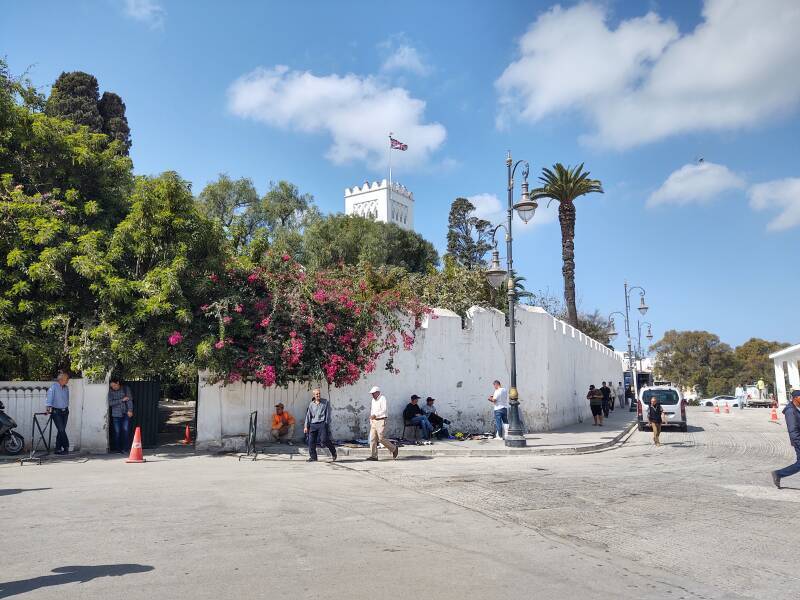
Its cemetery is home to a mix of actual graves and memorials, or cenotaphs, from the Greek κενοτάφιον meaning "empty tomb".
Some are those of Brits who were in foreign service, in international business, or killed in war. But not all. The British smuggler Paul Lund operated out of Tangier. He died there of tuberculosis in 1966 and is buried in the cemetery.
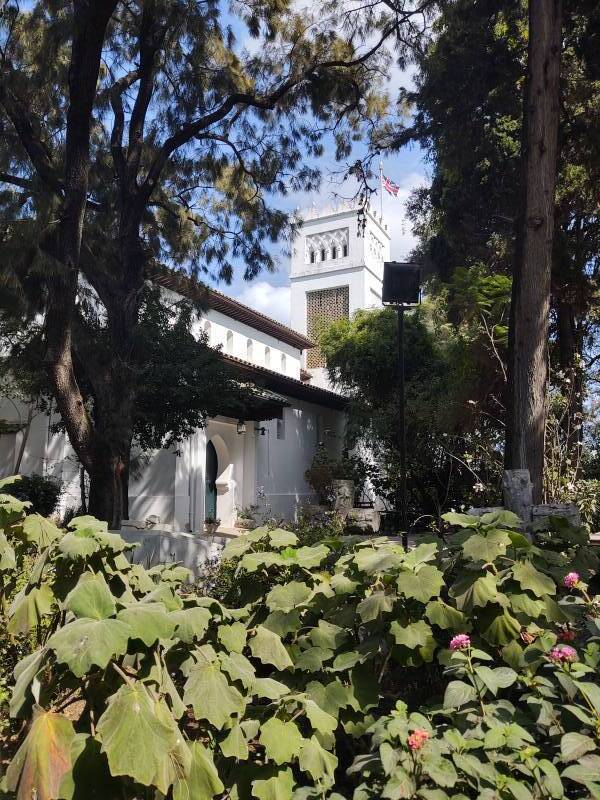

At right in the first picture below, the writer, journalist, and adventurer Walter Burton Harris, 1866-1933.
He came to Tangier in 1886 and was associated with The Times as correspondent in Morocco and elsewhere from 1887 till his death April 4th 1933. He loved the Moorish people and was their friend.
His physical appearance and fluency in French, Spanish, and Moroccan Arabic allowed him to pass as a native throughout the interior. He became a confidant of at least three Moroccan Sultans, and his writing in The Times led him into increasing involvement in international politics, sometimes helping but often interfering with the efforts of British dipolomats in Morocco. His travel writing made him the hero of every story, and the editor of a later collection of those works wrote that "it is hard to distinguish the truth from the legend" because he "loved to tell stories, especially about himself."
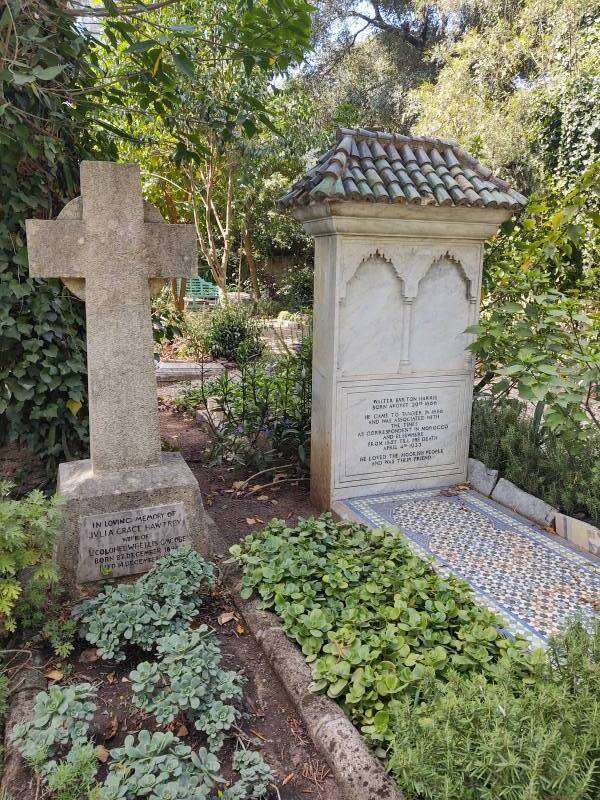
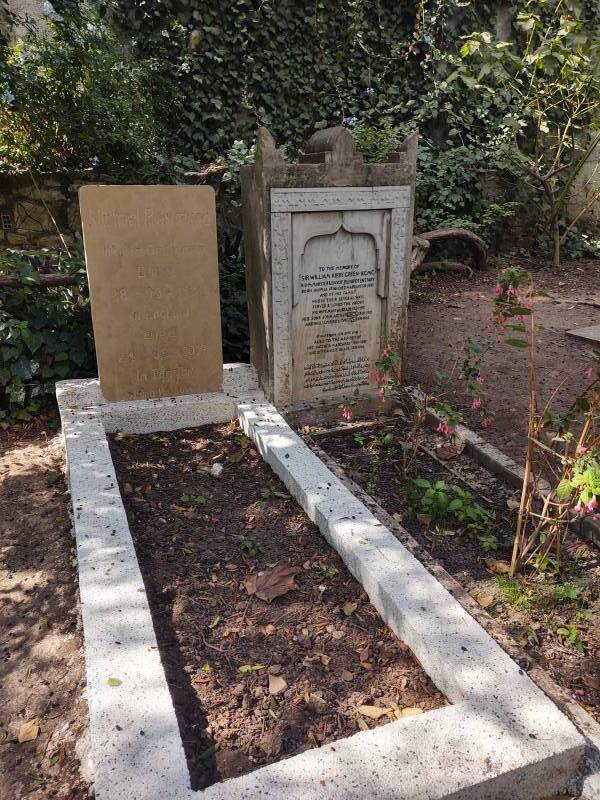
At right in the last picture above:
To the memory of Sir William Kirby Green KCMG. H.B.M. Minister and Envoy Plenipotentiary. Born Navplia [Greece] 1836, Died Marrakesh 1892, and of his family who in their several ways served and loved the Moors. His wife Mary Reade 1834-1911. His sons John Arthur "Jack" 1866-1912 and William Kirby "Co" CMC 1876-1945.
Then there are five lines of Arabic at the bottom. Two following generations of his family are commemorated inside the church.
He is described in the British Dictionary of National Biography as:
GREEN, Sir WILLIAM KIRBY MACKENZIE (1836–1891), diplomatist, born in 1836 at Nauplia in Greece, was the son of Sir John Green (d. 18 Sept. 1877), consul-general at Bucharest from 1867 to 1874, by his wife Margaret, daughter of George Suter. He was educated abroad and entered the consular service at the age of seventeen. In 1856 he became private secretary to the consul-general for Egypt, and in 1859 became secretary to (Sir) John Drummond Hay, remaining in the public service in Morocco for several years. He was vice-consul at Tetuan and acting consul at Tangier, and was engaged upon special missions in the court of Morocco at various times during the next ten years. In 1869 he was transferred to Tunis as acting agent and consul-general, and thence was moved to Damascus in 1871 and to Bairfit in 1873. In 1876 he was promoted to be consul at Scutari, and on 6 Jan. 1879 he became consul-general for Montenegro and the vilayet of Scutari. Here during three eventful years he did work which made his name familiar to the public. He consistently maintained the view that the Turkish government, though in urgent need of reform, was not beyond hope, and that the Christian subjects of the Porte were not faultless. He was frequently consulted by government, his opinions appeared in many blue-books, and he was freely attacked by the anti-Turkish party in England. In 1881 he was created C.M.G. in recognition of his services, and on 1 July 1886 he succeeded Sir John Drummond Hay as envoy to Morocco and consul-general at Tangier.
In Tangier Green's knowledge of oriental languages in which he was second only to Sir Richard Burton together with his diplomatic ability, gave him great influence with the sultan. He obtained several important concessions from Muley Hassan, among others the establishment of telegraphic communication between Tangier and Gibraltar, which the sultan had refused for the space of twelve years. On 10 Dec. 1890 he started on a special mission to Morocco to obtain from the sultan compensation for the destruction of the factories of the North-West Africa Company by a party of Bedouin Arabs. He was successful in his mission, but died suddenly at Morocco [Marrakech] on 25 Feb. 1891. He was buried at Tangier on 8 March. On 21 June 1887 he was created K.C.M.G.
Nearby are striking groups of stones. The groups of five and four placed "shoulder to shoulder" are for members of two air crews.

The group of five died on a mission on 31 January 1945. Left to right:
Lt. W. M. Allison, Observer, S.A.A.F.
Sgt. A. J. Boyles, Wireless Operator / Air Gunner, R.A.F.
Lt. J. H. Buxmann, Pilot, S.A.A.F.
Sgt. H. J. Hutchinson, Wireless Operator / Air Gunner, R.A.F.
Sgt. F. E. Turner, Wireless Operator / Air Gunner, R.A.F.

The group of four died on a mission on 21 February 1944. Left to right:
Unknown.
Flight Sgt. T. A. Hamilton, Navigator, R.A.F.
Sgt. J. P. Downs, Wireless Operator / Air Gunner, R.A.F.
Pilot Officer P. M. MacIntyre, Wireless Operator / Air Gunner, R.C.A.F.

At left rear:
Flight Lt. W. G. Walker, R.A.F., 12 June 1943.
Sgt. T. St. A. Henning, Gibraltar Security Police, 6 Feb 1942.
In between in the background is a small stone for Sonya Dragroze-Kamalakar, marked with a Russian Orthodox cross.
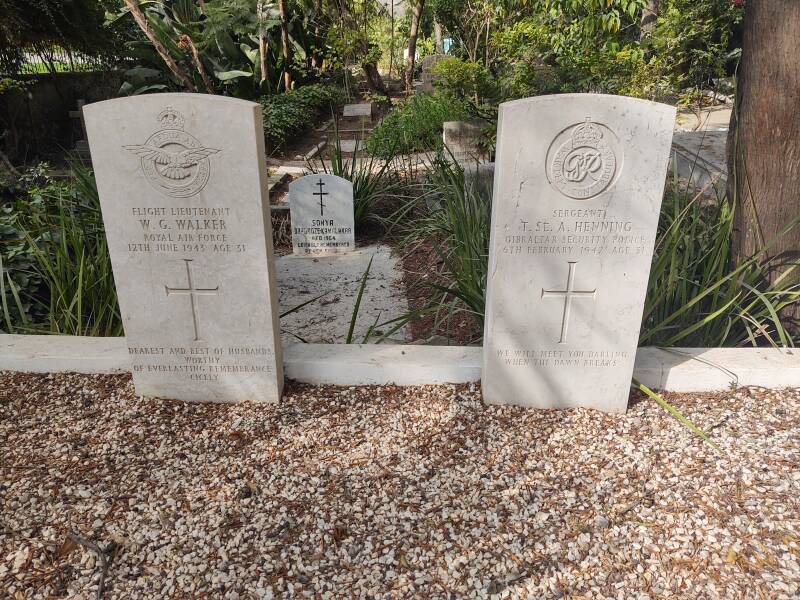
At right rear:
Pilot Officer J. A. Hawes, Navigator / Wireless Operator, R.A.F., 12 June 1943.
Flight Sgt. E. M. Rodwell, Pilot, R.A.F., 15 April 1945.

The interior of the church is a mix of styles but is primarily Moorish.
The Lord's Prayer in Arabic surrounds the gateway into the altar area.

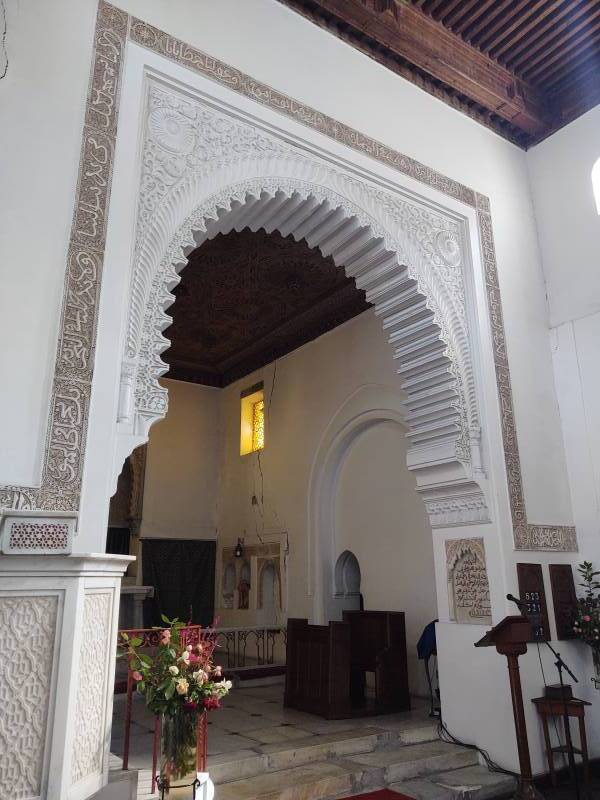
The niche behind the altar also functions as a mihrab, indicating the qibla or proper direction of Muslim prayer. Below the altar is the X-shaped cross of Saint Andrew.

A small niche in the right aisle is flanked by Orthodox icons. This church for expatriates is quite ecumenical, serving various communities.
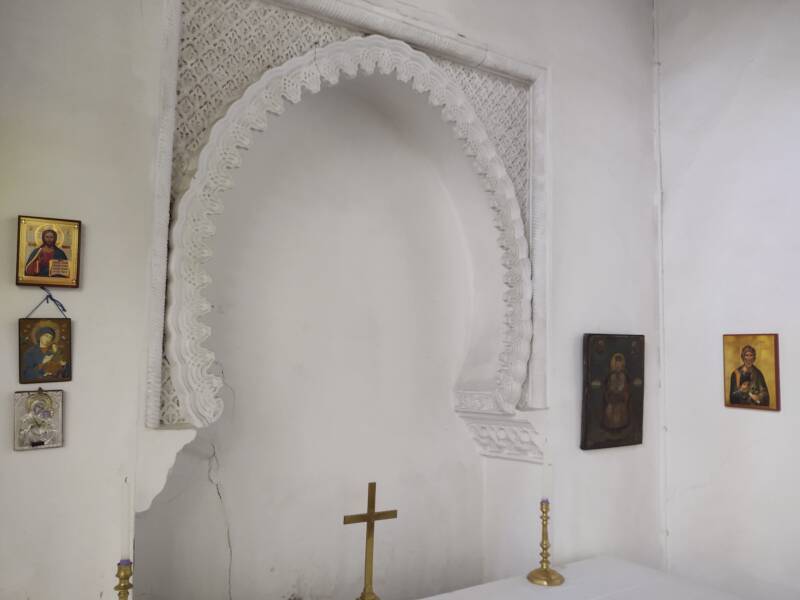
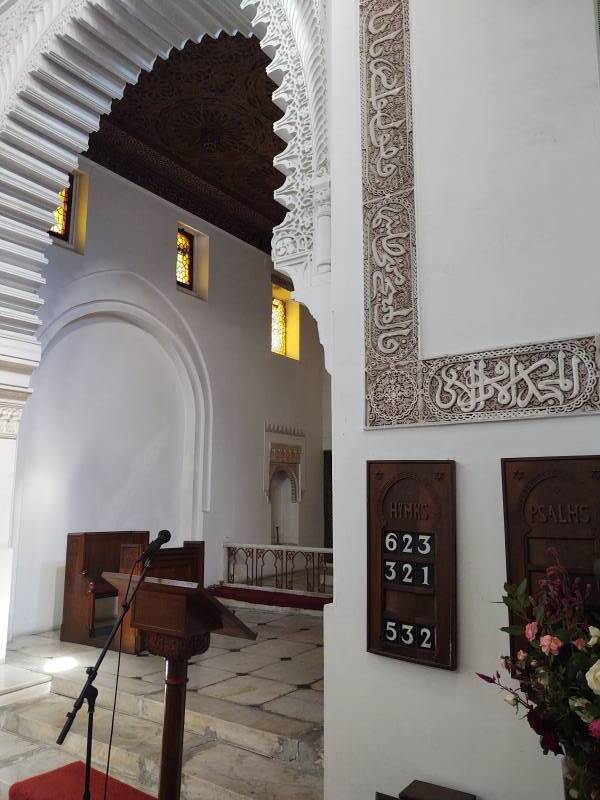
Two memorial plaques on the east wall commemorate the son and grandson of Sir William Kirby Green (1836-1892) whose gravestone in the cemetery is shown above.
His son was William Kirby-Green, who had been the Chief Provincial Commissioner of Nyasaland. The British Central Africa Protectorate was proclaimed in 1889. It was renamed Nyasaland in 1907. In 1964 it became the independent Republic of Malawi.
The grandson was Thomas Gresham Kirby-Green, who was born in Nyasaland in 1918. He was sent to boarding school in England, and when he graduated in 1935 he went to live with his parents in Tangier. He got a private pilot's licence and joined the RAF.
On 17 October 1941 he took off from RAF Alconbury, near Huntington in Cambridgeshire, as the pilot of a Vickers Wellington Mark Ic bomber. It was a mission to bomb factories in Duisburg, where the Rhine joins the Ruhr.
The plane was shot down. All the rest of the crew was killed, Kirby-Green was taken prisoner and taken, eventually, to the German POW camp Stalag Luft 3 in what today is southwestern Poland.
He took part in what came to be called the "Great Escape" of 24–25 March 1944, when he was one of 76 men to make it out of the camp through tunnels.
Of the 76 men who escaped, 73 were recaptured, most of them within several days. The German Gestapo murdered 50 of the men, cremating their bodies to better cover up the war crime.
Kirby-Green made it as far as Hodonín in today's Czech Republic, near the border with Austria. The Germans tortured him at Zlin, then shot him near Mahrisch Ostrau, now known as Ostrova, in the northwest of today's Czech Republic. They initially returned his ashes to the camp to serve as a discouragement against further escape attempts. His ashes were first buried nearby in Sagan, then were moved to the Old Garrison Cemetery in Poznan.
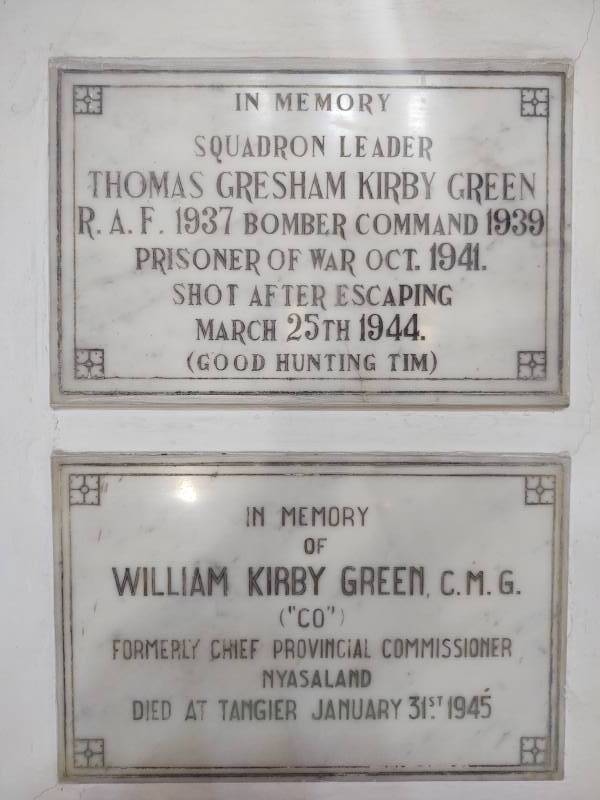
Another memorial plaque commemorates British victims of the First World War who had been living in Morocco.
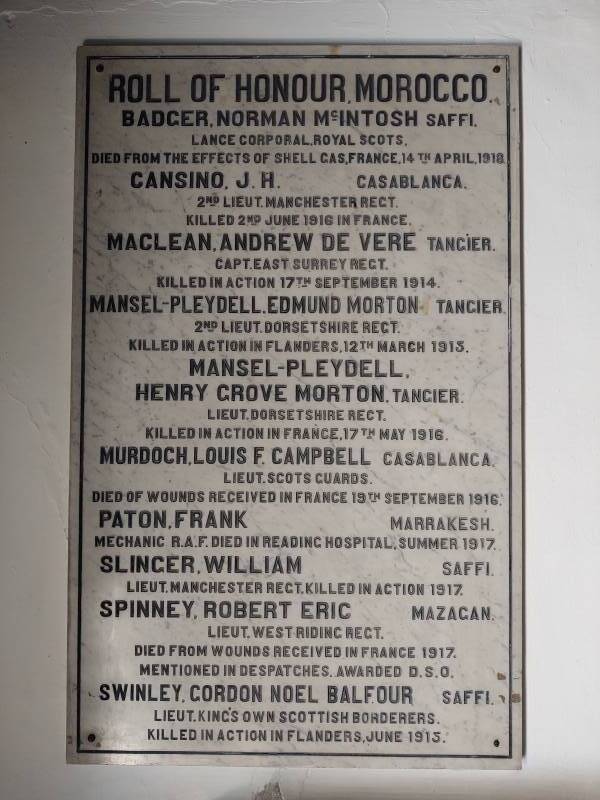
Another memorial is to Emily Keene (1849–1944), a British humanitarian who had married the Sharīf of Ouazzane, a local religious leader. She is credited with introducing cholera vaccination to Morocco. There was an especially bad wave of cholera in 1895 in northern Morocco. It's not clear just what Emily Keene actually did. Useful cholera vaccines were developed in 1884–1896. Morocco was the last North African country in which a Pasteur Institute was created — the first in Tangier in 1913, nearly twenty years after those in Tunisia and Algeria, with a second one established outside the International Zone in Casablanca in 1932.
Delacroix, Matisse, and Other Artists in Tangier
The French diplomat Count de Mornay traveled to Tangier in 1832 to establish a treating supporting France's recent annexation of Algeria. The painter Eugène Delacroix accompanied him, and returned on several later visits.
Delacroix was inspired by the exotic nature of Morocco, and also took it as a living model for classical antiquity, writing "The Greeks and Romans are here at my door, in the Arabs who wrap themselves in a white blanket and look like Cato or Brutus."
He sketched and painted in a rush, writing "I am like a man in a dream, seeing things he fears will vanish from him." He used his sketches to create eighty oil paintings set in Morocco through the rest of his career.
One thing he saw in 1832 was the devotional activity of members of the 'Isawiyya brotherhood. That's a mystical brotherhood founded in Meknès by Sheikh al-Kamil Mohamed al-Hadi ben Issa (1465-1526), known as the "Perfect Sufi Master".
They're known for their group recitation of religious psalms accompanied by the ghaita a double reed wind instrument, and polyrhythmic percussion. That is accompanied by symbolic dances that bring the participants to an ecstatic trance state.
Five years later that led to Delacroix's 1837–1838 painting known as Convulsionists of Tangier and as The Fanatics of Tangier. It's now in the collection of the Minneapolis Institute of Art.

Henri Matisse was struck by Delacroix's works and made several trips of his own to Tangier, spending seven months there in 1912 and 1913. He always stayed at the Grand Hôtel Villa de France, with a view to the medina and kasbah.

Looking out his hotel room window, he made an oil painting variously known as La Fenêtre à Tanger, Paysage vu d'une fenêtre, Landscape viewed from a window, Tangier, and most simply, Window at Tangier. It is held at the Pushkin Museum of Fine Arts, Moscow.
In it you see Saint Andrew's Church and the walls of the medina, with the minaret of the Friday mosque at right.

The Russian collector Ivan Morozov bought this work directly from Matisse when he was back in Paris. After the Russian Revolution the Morozov collection was confiscated by the covernment. In 1948 it and the collection of Sergei Shchukin were "donated to the public" at the Pushkin Museum of Fine Arts in Moscow and the Hermitage in Sankt-Peterburg. This work ended up at the Pushkin Museum.
Hotel Continental
The Hotel Continental was built in 1870, it's one of the oldest hotels remaining in Tangier.

The artist Edgar Degas stayed at the Continental, as did Winston Churchill when he was a war correspondent. The hotel still has the old register pages recording their stays.

The hotel still looks like the 1920s and 1930s inside and out. It's like a set for the great Poirot series with David Suchet.
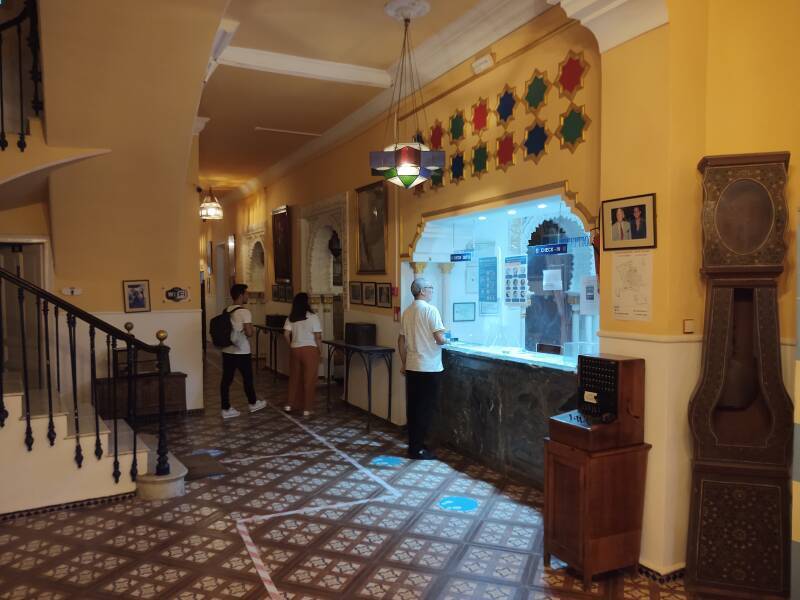
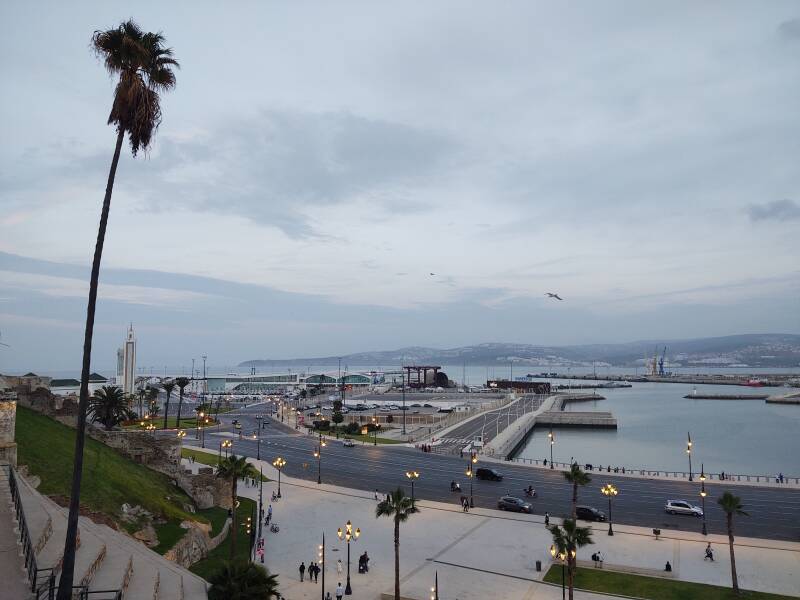
The terrace has a wonderful view down over the port, the waterfront of the ville nouvelle, and the lower end of the medina.
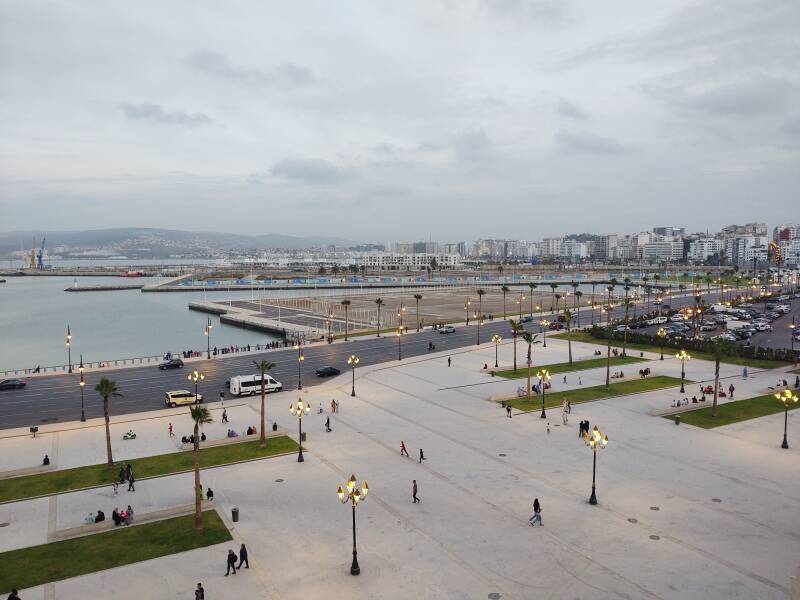

I would pass back through Tangier toward the end of the trip. But now it was time to move on to Meknès.